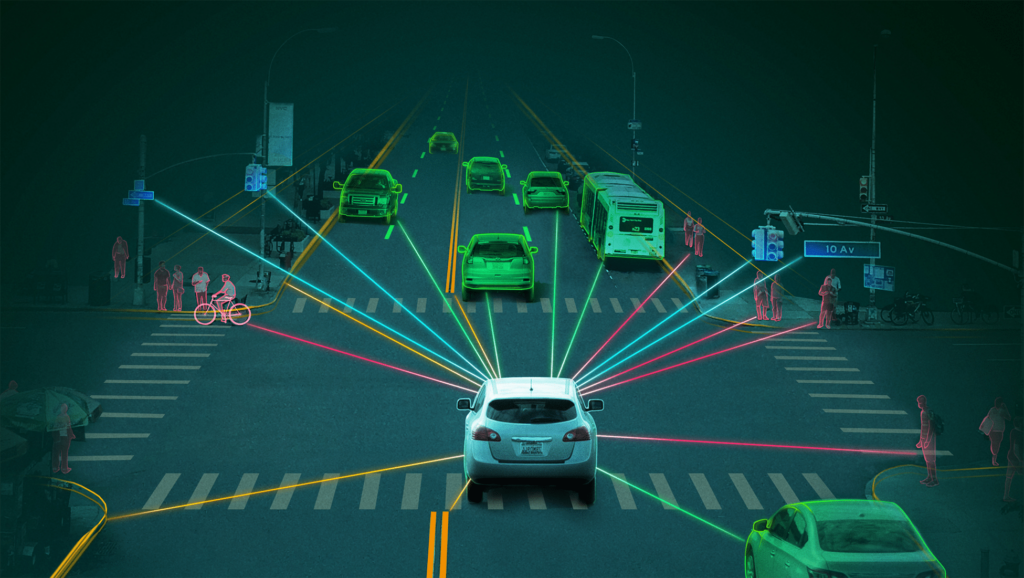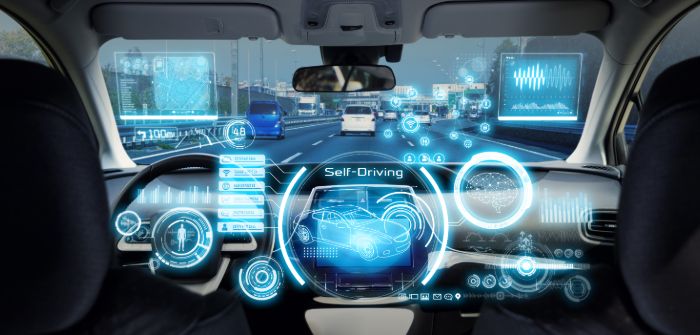Autonomous vehicles represent a transformative breakthrough in the realm of transportation, promising to revolutionize how we travel and commute.
The advent of autonomous vehicles holds great potential in terms of safety, efficiency, and convenience. With the ability to eliminate human error, autonomous vehicles aim to reduce accidents and increase road safety. They also have the potential to optimize traffic flow, reduce congestion, and enhance fuel efficiency. The introduction of autonomous vehicles marks a significant shift in transportation, with implications for various sectors and a promising future ahead.
What is an Autonomous Vehicles?
Autonomous vehicles, also known as self-driving cars or driverless vehicles, are vehicles equipped with advanced technologies and sensors that enable them to navigate and operate without human input or intervention. These vehicles use a combination of sensors, cameras, radar, lidar, and artificial intelligence algorithms to perceive the environment, make decisions, and control their movement.

Advantages of Autonomous Vehicles
- Increased safety: Autonomous vehicle have the potential to significantly reduce accidents caused by human error, which is responsible for the majority of road accidents. With advanced sensors and algorithms, autonomous vehicles can better detect and respond to potential hazards, leading to safer roads.
- Improved efficiency: Autonomous vehicle can optimize traffic flow and reduce congestion by communicating with each other and coordinating their movements. This can result in smoother traffic patterns, reduced travel times, and improved fuel efficiency.
- Enhanced accessibility: Autonomous vehicles can provide transportation options for individuals who are unable to drive due to age, disability, or other limitations. It can improve mobility for the elderly, disabled, and those without a driver’s license, making transportation more inclusive.
- Increased productivity: Autonomous vehicle can free up time for passengers to engage in other activities during their commute, such as working, reading, or relaxing. This can lead to increased productivity and a better utilization of travel time.
- Environmental benefits: Autonomous vehicles have the potential to be more fuel-efficient and reduce emissions by optimizing routes, reducing idling time, and promoting smoother traffic flow.
- Potential cost savings: Autonomous ride-sharing services could offer cost-effective transportation alternatives, reducing the need for individual car ownership and associated expenses like insurance, maintenance, and parking.
- Reduced parking space requirements: With the ability to drop off passengers and find parking on their own, autonomous vehicles can alleviate the need for large parking areas, potentially freeing up space for other purposes.
- Improved traffic management: By analyzing traffic data in real-time, autonomous vehicles can contribute to more effective traffic management strategies, such as dynamic traffic signal control and congestion prediction.
- Enhanced road infrastructure: Autonomous vehicle can communicate with road infrastructure systems, allowing for better coordination and optimized traffic flow at intersections and highway merges.
- Technology advancements: The development of autonomous vehicle can drive advancements in related technologies, such as sensors, AI, and connectivity, which can have positive impacts across various industries and sectors.
It is important to note that while the advantages of autonomous vehicles are promising, challenges and considerations related to safety, cybersecurity, regulations, and public acceptance need to be addressed for their widespread adoption and integration into existing transportation systems.
Environmental Benefits of Autonomous Vehicles
- Improved fuel efficiency: Autonomous vehicle can optimize routes, reduce idling time, and minimize aggressive driving behaviors, resulting in improved fuel efficiency and reduced carbon emissions.
- Traffic flow optimization: By communicating with each other, autonomous vehicles can coordinate movements and reduce traffic congestion, leading to smoother traffic flow and decreased emissions from idling vehicles.
- Efficient driving patterns: Autonomous vehicle can utilize advanced algorithms to maintain optimal driving speeds, reduce unnecessary acceleration and braking, and improve overall fuel efficiency.
- Electric vehicle integration: Autonomous vehicles can be easily integrated with electric vehicle technology, promoting the adoption of electric cars and reducing reliance on fossil fuels.
- Eco-friendly driving behaviors: With advanced sensors and algorithms, autonomous vehicles can adhere to eco-friendly driving behaviors, such as maintaining consistent speeds, anticipating traffic patterns, and minimizing unnecessary stops, which contribute to reduced emissions.
- Reduced need for parking: Autonomous ride-sharing services can decrease the need for individual car ownership and parking spaces, freeing up land for green spaces or alternative development, reducing urban sprawl, and preserving natural habitats.
Impacts of Autonomous Vehicles:

- Safety improvements: Autonomous vehicle have the potential to significantly reduce human error-related accidents, saving lives and reducing injuries on the road.
- Economic changes: The widespread adoption of autonomous vehicles could disrupt various industries, such as transportation, logistics, and delivery services. Job displacement in certain sectors may occur, while new employment opportunities in autonomous vehicle development and maintenance may arise.
- Urban planning and infrastructure: The integration of autonomous vehicle will require updates to infrastructure, such as road signage, traffic management systems, and communication networks. Cities may need to adapt their urban planning to accommodate the changing transportation landscape.
- Changes in transportation behavior: With autonomous vehicles offering convenience and ease, people may opt for shared mobility services or use on-demand autonomous vehicles instead of owning personal cars. This shift in behavior could impact car ownership rates, parking demand, and transportation patterns.
- Environmental impacts: Autonomous vehicles have the potential to improve fuel efficiency, optimize traffic flow, and facilitate the adoption of electric and alternative fuel vehicles, reducing carbon emissions and contributing to environmental sustainability.
- Accessibility and inclusivity: Autonomous vehicles can provide increased mobility options for individuals who are unable to drive, such as the elderly and people with disabilities, enhancing their quality of life and independence.
- Regulatory and legal considerations: The implementation of autonomous vehicle requires the establishment of comprehensive regulations and legal frameworks to address liability, safety standards, data privacy, and cybersecurity concerns.
It is essential to carefully consider and address these impacts to ensure a smooth and successful transition towards a future with autonomous vehicles.
Challenges and Limitations of Autonomous Vehicles
- Safety concerns: While autonomous vehicle have the potential to enhance road safety, ensuring their reliability and ability to handle complex and unpredictable scenarios remains a significant challenge. Robust safety measures, including fail-safe mechanisms and thorough testing, are necessary to gain public trust.
- Technological limitations: Autonomous vehicle heavily rely on advanced technologies, such as sensors and AI algorithms. Technical limitations, such as sensor accuracy in adverse weather conditions or complex urban environments, still need to be addressed to ensure reliable performance.
- Legal and regulatory frameworks: Developing comprehensive regulations and legal frameworks to govern autonomous vehicles is crucial. Determining liability in the event of accidents, ensuring data privacy, and addressing ethical considerations are complex challenges that require careful attention.
- Infrastructure requirements: Autonomous vehicle require infrastructure support, such as high-quality mapping systems, intelligent transportation systems, and robust communication networks. The integration of these systems into existing infrastructure presents challenges in terms of cost, compatibility, and deployment.
- Public acceptance and trust: Widespread adoption of autonomous vehicles hinges on public acceptance and trust. Addressing concerns related to safety, cybersecurity, privacy, and job displacement is essential to gain public confidence in autonomous technology.
- Transition period: The transition from traditional vehicles to fully autonomous ones may involve a mix of human-driven and autonomous vehicles, leading to complex interactions on the road. Establishing clear guidelines and protocols during this transition period is necessary to ensure safety and smooth integration.
- Affordability and accessibility: The cost of autonomous technology remains a barrier to widespread adoption. Ensuring affordability and accessibility of autonomous vehicle for all segments of society is a challenge that needs to be addressed.
The Role of Artificial Intelligence in Autonomous Vehicles
- Perception and Sensing: Artificial Intelligence (AI) plays a crucial role in the perception and sensing capabilities of autonomous vehicles. AI algorithms analyze data from various sensors, including cameras, lidar, radar, and ultrasonic sensors, to understand and interpret the surrounding environment. This enables the vehicle to detect objects, pedestrians, road markings, and obstacles, allowing for real-time decision-making.
- Decision-making and Planning: AI algorithms are responsible for decision-making and planning in autonomous vehicles. These algorithms evaluate sensor data, traffic conditions, and predefined rules to determine appropriate actions, such as accelerating, braking, changing lanes, and making turns. AI enables autonomous vehicles to navigate complex scenarios, handle unexpected situations, and make informed decisions in real-time.
- Machine Learning and Adaptability: Machine learning, a subset of AI, plays a vital role in autonomous vehicles. Through continuous learning from vast amounts of data, autonomous vehicles can improve their performance over time. Machine learning algorithms help in identifying patterns, refining perception systems, and optimizing decision-making processes. This adaptability allows autonomous vehicles to enhance their capabilities, responsiveness, and overall safety.
The continuous advancements in AI technology will further refine and enhance the capabilities of autonomous vehicles, making them more reliable, efficient, and safe for transportation.
The Future of Autonomous Vehicles

The future of autonomous vehicle holds immense potential to revolutionize transportation as we know it. Here are three key points that illustrate the exciting prospects of autonomous vehicles:
- Safety and Efficiency: Autonomous vehicles have the potential to greatly enhance road safety. By eliminating human error, which is responsible for the majority of accidents, autonomous vehicles can significantly reduce the number of collisions. Advanced sensors, cameras, and artificial intelligence algorithms allow these vehicles to perceive and react to their surroundings with greater precision and speed. Moreover, autonomous vehicles can optimize traffic flow, reduce congestion, and minimize fuel consumption through intelligent route planning and coordinated communication with other vehicles.
- Enhanced Mobility and Accessibility: Autonomous vehicle have the power to transform mobility for individuals who are unable to drive, such as the elderly and disabled. With autonomous technology, they gain newfound independence and access to convenient transportation options. Additionally, autonomous ride-sharing services can offer cost-effective and efficient solutions, reducing the need for private car ownership and freeing up parking spaces in crowded urban areas.
- Environmental Sustainability: The integration of autonomous vehicle can contribute to a greener and more sustainable future. By optimizing driving patterns, reducing unnecessary idling, and promoting the use of electric or alternative fuel vehicles, autonomous technology can significantly reduce carbon emissions. The potential widespread adoption of autonomous electric vehicles could lead to cleaner air, decreased reliance on fossil fuels, and a positive impact on environmental conservation.
- Economic Opportunities: The rise of autonomous vehicle brings forth new economic opportunities. Industries related to autonomous vehicle technology, including manufacturing, software development, and infrastructure, will experience growth. Job creation in fields such as AI engineering, data analysis, and maintenance services will emerge as autonomous vehicles become more prevalent. Additionally, the integration of autonomous vehicles can drive advancements in smart city infrastructure, creating a ripple effect of economic development and improved urban planning.
The autonomous vehicles promises safer roads, enhanced mobility, environmental sustainability, and economic growth.
Future Applications and Use Cases of Autonomous Vehicles
- Ride-Sharing and Mobility Services: Autonomous vehicle can revolutionize the ride-sharing industry by providing on-demand transportation without the need for human drivers. This can lead to more efficient and cost-effective transportation options for commuters and reduce the number of private vehicles on the road.
- Goods Delivery and Logistics: Autonomous vehicle can transform the logistics and delivery sector by enabling efficient and reliable transportation of goods. Self-driving trucks and drones can streamline delivery processes, reduce costs, and improve supply chain management.
- Public Transportation: Autonomous vehicle can enhance public transportation systems by providing autonomous buses or shuttles. These vehicles can optimize routes, reduce congestion, and improve accessibility to underserved areas.
- Healthcare and Medical Services: Autonomous vehicle can be used for medical purposes, such as transporting patients to healthcare facilities or delivering medical supplies to remote areas. This can improve response times and access to healthcare services, especially in emergency situations.
- Last-Mile Delivery: Autonomous vehicles, including robots and drones, can play a vital role in last-mile delivery services. They can efficiently deliver packages or groceries to customers’ doorsteps, reducing delivery times and increasing convenience.
- Urban Infrastructure and Smart Cities: Autonomous vehicles can contribute to the development of smart cities by integrating with infrastructure systems. They can communicate with traffic signals, parking systems, and other vehicles, enabling efficient traffic management and reducing congestion.
- Agriculture and Farming: Autonomous vehicles can be used in agriculture for tasks like planting, harvesting, and spraying crops. This can increase efficiency, reduce labor requirements, and improve yields in the agricultural sector.
As technology advances and regulations evolve, these future applications and use cases of autonomous vehicle have the potential to reshape industries and improve various aspects of our daily lives.
Conclusion
Autonomous vehicles hold the promise of revolutionizing transportation as we know it. With enhanced safety, increased efficiency, and a multitude of applications, they have the potential to transform the way we travel. From reducing accidents and congestion to improving accessibility and sustainability, autonomous vehicles are set to redefine the future of transportation. However, addressing challenges related to safety, regulations, and public acceptance is crucial for their successful integration.


